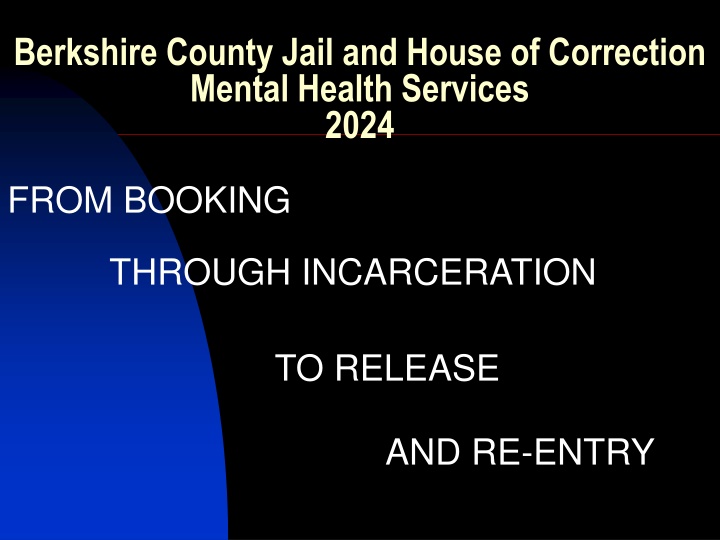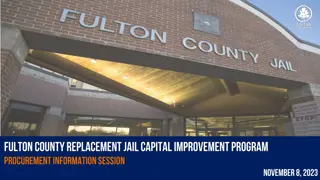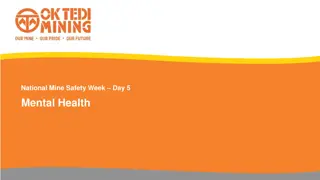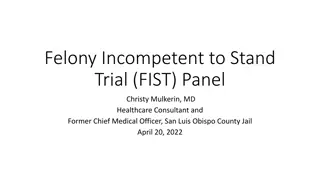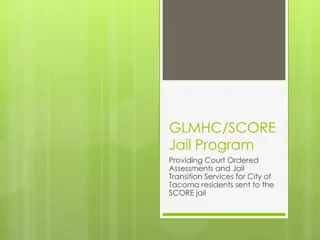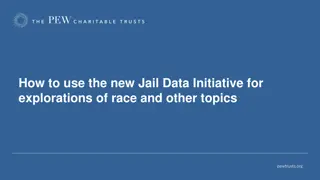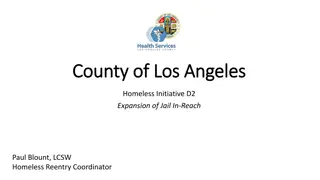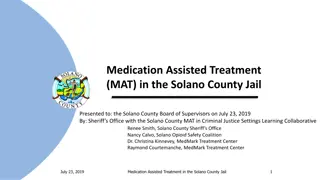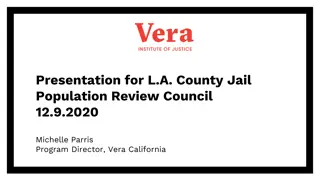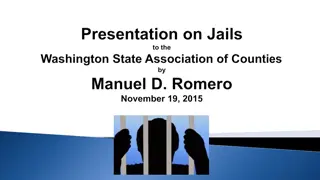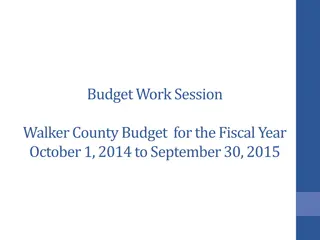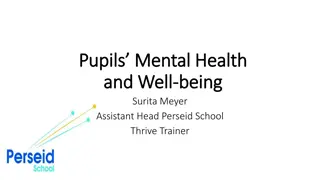Berkshire County Jail Mental Health Services 2024
Mental health services provided at Berkshire County Jail and House of Correction include full-time clinicians, suicide risk assessments, crisis intervention, ongoing treatment, and re-entry support. Statistics reveal the high suicide rates in correctional facilities, emphasizing the importance of early mental health intervention.
Download Presentation

Please find below an Image/Link to download the presentation.
The content on the website is provided AS IS for your information and personal use only. It may not be sold, licensed, or shared on other websites without obtaining consent from the author.If you encounter any issues during the download, it is possible that the publisher has removed the file from their server.
You are allowed to download the files provided on this website for personal or commercial use, subject to the condition that they are used lawfully. All files are the property of their respective owners.
The content on the website is provided AS IS for your information and personal use only. It may not be sold, licensed, or shared on other websites without obtaining consent from the author.
E N D
Presentation Transcript
Berkshire County Jail and House of Correction Mental Health Services 2024 FROM BOOKING THROUGH INCARCERATION TO RELEASE AND RE-ENTRY
MENTAL HEALTH 3 Full Time Master Level Clinicians 1 Full Time Mental Health Coordinator 4 hrs twice a month access to Psychiatric consultation Suicide Risk Assessment Mental Health Assessment Crisis Intervention On-going Treatment/Respond to Request Slips Group Facilitation Review Psychotropics (56% of pop) at 2 weekly meetings 78% of pop identified with Mental Illness Past/Present 28% of pop identified as Suicidal Past/Present Aftercare Referrals and Placement Coordination with Courts, DMH and other Area Agencies 24/7 Mental Health Coverage
Scope of the Problem Who do you think has the highest suicide rate? 1) Prisons 2) Jails and Houses of Correction 3) The Community WHY? 3
Suicide Statistics in Corrections (Carson, Dec 2021) In the U.S. in 2019, suicide made up 1.7% of deaths (Xu, Murphy, Kochanek, & Arias, 2021) In 2019, 29.6% of jail inmate deaths were due to suicide. Suicide has been the leading cause of death in jails every year since 2000. Pre-Trial detainees are 7X more likely to commit suicide then sentenced inmates The nations smaller jails have a 6X higher rate of successful suicides in comparison to the larger jails
When does the Mental Health Team become involved? Mental team becomes involved as soon as an I/M is received into the facility. Could be the result of follow up from initial intake or get involved as the I/M progresses through their incarceration. Pod officers, Shift commanders, Case Management, Educators and Medical can make referrals and I/M s can request to be seen by a clinician. Approximately 78% of our population are tracked by the Mental Health Team 5 3/4/2025
Suicide Screening Flow Chart Inmate Arrives at BCHC Medical Screening (by LPN or RN) Mental Health Screening (by Masters Level Clinician) Booking Screening (by Booking/Screening Officer) Shift Supervisor Screening (by Shift Supervisor) Assigned Pod and Supervision Level Mental Health Intake/Assessment (by Unit Mental Health Clinician) (usually within 3 work days) Pod Orientation (by Pod Officer) (usually prior to cell placement) Case Management Intake/Orientation (by Pod Case Manager) (usually within 1 work day) Daily Unit Meeting (Within 1 Work day) Members include Security, Classification, Mental Health and Case Management Unit Team Meeting (Weekly Reviews) Mental Health Meetings (Twice Weekly) Mental Health Team at 2 meetings Staff Physician and Consulting Psychiatrist at 1 meeting Members include Security, Medical, Classification, Education, Mental Health, Case Management and Substance Abuse
SUICIDE RISK ASSESSMENT UNIQUE FEATURES Masters Level Clinician assesses every inmate in Booking Follow up intake by Case Management on Day 1 Follow up intake by Mental Health within 3 days (usually sooner) Coordination of information at Daily Unit Meeting, Weekly Team Meetings and 2 Weekly Mental Health Meetings Suicide Policy and Procedures and General Departmental structure lauded by auditors from ACA and NCCHC. In 2014 NCCHC designated our Suicide Prevention as Program of the Year. Last successful suicide was in 2021 prior suicide was in 1984.
Receiving/Screening From 8am through 8pm Monday thru Friday Mental Health will do a face to face structured suicide risk assessment and initial mental health consult on every new arrival. Arrivals after 8pm are screened by Custodial Staff and minimally placed on Active Monitoring until rescreened by Mental Health Mental Health Team: Determines the level of Monitoring Consults with Pod officers, Shift Commanders, and Unit Managers in determining appropriate housing. 8 3/4/2025
Crisis Referrals All Crisis referrals are communicated by the Case Manager or Pod Officer directly to the ADS of Mental Health or the Mental Health Team during regular working hours. Referrals made after hours should always be made in writing and a message left on ext 1138. If the I/M seems unsafe to self or others, the pod officer should confer with the shift commander and designate the appropriate level of monitoring. Consult with the On-Call Clinician Any staff can upgrade a monitoring level Only the mental health team can downgrade the level of monitoring. 9 3/4/2025
Crisis is a need for immediate intervention. I/M is making or, has attempted to make, an attempt on their life. I/M is talking about ending their life. I/M is behaving in an irrational manner. In general any situation that the pod officer feels a mental health clinician needs to become involved ASAP. 10 3/4/2025
Mental Health Clients Are assigned 1 of 4 levels of contact based on their need and risk level Daily Contact 3x Weekly Contact 2x Monthly Contact 1x Monthly Contact In addition the Mental Health Team responds to inmate request slips and/or staff referrals 11 3/4/2025
Monitoring Levels Constant: Imminent Risk. Face to face contact at all times. Posted position Active: Moderate to High Risk (5X hourly random checks) Routine: Minimal risk (2x hourly) 12 3/4/2025
A Note About Us As mentioned earlier the last suicide at BCHC was in 2021 with the previous successful suicide occurring in1984. That span of 37 years between successful suicides is an astonishing feat given the number of high risk men and women we have processed over the years. It is a direct reflection on the level of commitment that staff both past and present have to keep those in our care and custody safe. It is truly a team effort. It takes Custodial, Medical, Mental Health, Substance Use, Case Management, Education, Support Staff and a proactive Administration working together and communicating to mount such a successful track record.
In Conclusion Our involvement begins at Admission (or earlier) and continues well beyond release Our Department is designed in a way that encourages communication within the department and through the Team Meetings and Daily Unit Meeting to the entire facility A strong Programs and Treatment Department enhances the security of the facility and decreases the suicide risk. The more inmates are involved in programming and the better we know them, the more we can avert or minimize inmate safety issues (i.e. lower suicide risk) and decrease tension in the facility Thank You Mark Massaro and Ed Capeless
